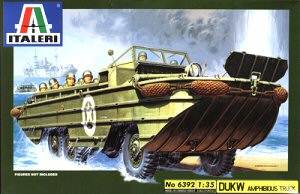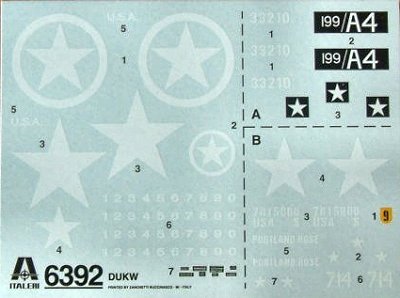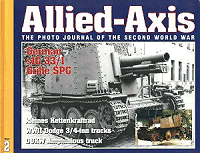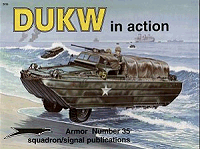

DUKW
Amphibious Truck
Italeri Kit #6392
1:35th Scale
First Look by Peter Brown


Introduced into service 1943, the DUKW served first in Sicily, then on through the Italian and North-West European campaigns and also in the Pacific although the tracked LVT series were more common there and it was also used in Burma. It continued in use in military service for many years post-war, several found their way into civilian agencies as emergency and rescue vehicles, others have been used with greater or lesser degrees of modification as pleasure craft and several preserved ones appear at vehicle rallies.
The
Kit:
The kit comes moulded
in typical Italeri style, there are three large sprues with one having just
the lower hull and upper deck as two parts, another has the hull sides and most
of the upper details while a third has the wheels, axles and the final detail
parts. A small sprue of clear parts with windscreen and headlight lenses completes
the kit itself. Moulding is clean enough at least for me, most knockout pins
are in areas which will not be seen when the model is built and the same goes
for the few shallow sink marks. This is a large kit of a large vehicle, the
main lower hull part is around 10.5" or 26.7cm long and its solid profile
makes it look big.
That said it is a fairly plain model. There is no tarpaulin or tilt, no crew are provided and no cargo though all can be added from scratch and no doubt aftermarket sets will appear in rapid succession. As it was in production from 1943 to 1945 there were several changes in design, some minor and some internal, and the kit certainly does not depict one of the initial 2000 or so vehicle with the vertical windscreen and spare wheel on the left hand side. Apart from these areas, the overall appearance of the DUKW did not change greatly, though a small proportion of vehicles carried a .5" Browning on a ring mount above the co-driver's position these vehicles looked fairly similar.
Some areas have
been simplified in the design of the kit. The large scooped-out areas at the
sides of the cab have been all but filled in with a moulded-on mesh panel, this
does not appear in all photos but may reflect a design change during production.
The mesh cover over the large air intake behind the crew area would also benefit
from being replaced by finer mesh.
Windscreen frame is moulded as part of the cab front, basic wipers are included
though the main and side glassware is way above scale thickness.
Cutting the windscreen frame off and repositioning it in the down position will
add some variety, and the front surf plate (part 52A) is also only designed
to be fitted up though it is a simple matter to leave off the supporting stays
and depict it lowered flat as it would usually be on land.
There has been some attention to detail underneath, with the several drain plugs
being depicted though these will not be seem on most completed models.
Access hatch for the engine is also moulded separate for those who want to add
an engine from scratch assuming one does not come in an aftermarket set.
One omission on the model is the large cover plates which went over the wheels. These were not fitted to all vehicles and if I had the choice of them being missed off over being moulded as part of the hull sides I would go for them as depicted, but having them as separate optional parts would have been almost ideal. Modelling them will be easy enough with thin plastic card however. Several photos show lines for the external tire inflation/deflation system though these are not seen when the wheel arches are covered anyway.
Overall first impressions of the kit before building are favourable, no doubt details could be improved or changed and additions made. The machine gun mount on the DUKW was the same M36 pattern used on the GMC deuce-and-a-half so a ready source would be the Tamiya accessory set. A tilt would be more work though most vehicles in wartime photos do not seem to have had them. Final finish will depend on what modellers want to depict, and the vehicle was used in a variety of locations at different times so there is no real shortage of options. Dioramas of vehicles being loaded or unloaded, a variety of cargoes - stores, troops or even artillery are typical ones - as well as colours will keep people researching and painting for a long while.
 Kit
decals and colour schemes cover three basic finishes. Two are described as US
Army vehicles in plain Olive Drab. Of these, that described as Normandy 1944
has markings more typical of British DUKWs from the D Day period and a published
photo shows the vehicle depicted ferry the Free French leader General De Gaulle
ashore in mid-June. I suspect there would be other markings at the front and
back, the call signs seem to have appeared on the cab front and trim vanes as
well as the side. The Germany 1945 decals are closely patterned on a vehicle
photographed on a pre-D Day exercise with MPs being ferried ashore, the name
PORTLAND ROSE suggests somewhere in the Portland area of Dorset. Third option
is for a US Marines vehicle on Iwo Jima 1945, this is in a green-tan-sand colour
scheme and the suggestion to use one of two styles of white star and making
up the vehicle serial from
Kit
decals and colour schemes cover three basic finishes. Two are described as US
Army vehicles in plain Olive Drab. Of these, that described as Normandy 1944
has markings more typical of British DUKWs from the D Day period and a published
photo shows the vehicle depicted ferry the Free French leader General De Gaulle
ashore in mid-June. I suspect there would be other markings at the front and
back, the call signs seem to have appeared on the cab front and trim vanes as
well as the side. The Germany 1945 decals are closely patterned on a vehicle
photographed on a pre-D Day exercise with MPs being ferried ashore, the name
PORTLAND ROSE suggests somewhere in the Portland area of Dorset. Third option
is for a US Marines vehicle on Iwo Jima 1945, this is in a green-tan-sand colour
scheme and the suggestion to use one of two styles of white star and making
up the vehicle serial from
the individual digits provided suggests these are more generic than specific
though it matches schemes in published references.
References are
not plentiful alas. There is a Squadron-Signal In-Action on the DUKW
(No 2035 ISBN 0-89747-372-8 by Timothy J Kutta) which has several photos of
them in action but it is not strong on detail or close-up shots though it does
have a couple showing the engine, nor does it have the line drawings following
production changes seen in many titles in this series. It does have colour side
views but note that the so-called "one of the first production vehicles"
has the later-style windscreen and the "all-white British" example
is actually pale grey which is the scheme used for many years post-war. Another
readily available source is the Concord on US Amtracs and Amphibians
at War (No 7032 ISBN 962-361-655-4 by Steve Zaloga and George Balin) though
this has far more on the Amtracs it has some good photos of DUKWs in Europe
including some better detail shots than those in
the Squadron book.
Best source I have is a long out of print paperback, mv-2 DUKW 2 1/2 ton 6x6 Amphibian by Jeff Woods from ISO Publications in London, England (no ISBN quoted). Published back in 1978 it has a good mix of detail and general photos, extracts from the user manual, some colour schemes, a separate fold-out sheet with an outline plan and cutaway drawing plus detailed measurements and also far more on British vehicles than the other books listed. It you want a good reference I can recommend this though finding a copy may not be easy.



|
|
|
|
|
 WWII
US War Department WWII
US War DepartmentTechnical Manual CD-ROM TM9-802 US 2 1/2 Ton, 6x6 Amphibian Truck (DUKW - 353) Easy 1 Productions #T025 |
 Allied-Axis Allied-AxisThe Photo Journal of the Second World War No.2 Ampersand Publishing. The publishers of MMIR magazine. 96 pages soft cover. |
 DUKW
in Action DUKW
in ActionSquadron/Signal books #2035 ISBN 0-89747-372-8 |
|
|
|
Page Created 23 August 2002